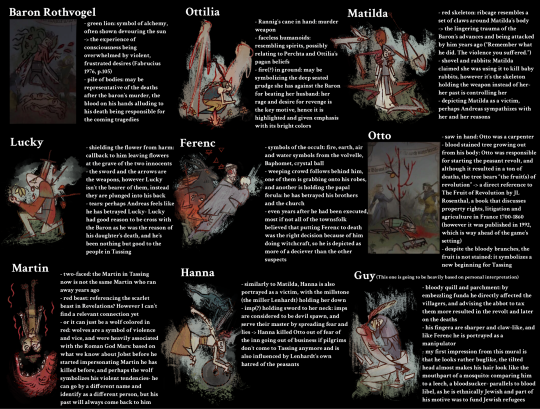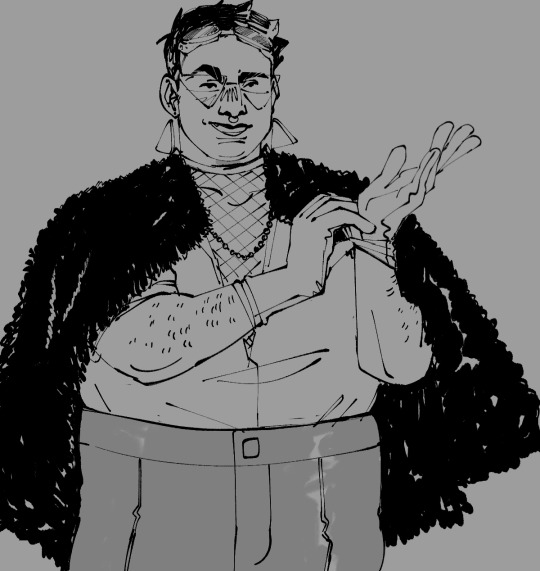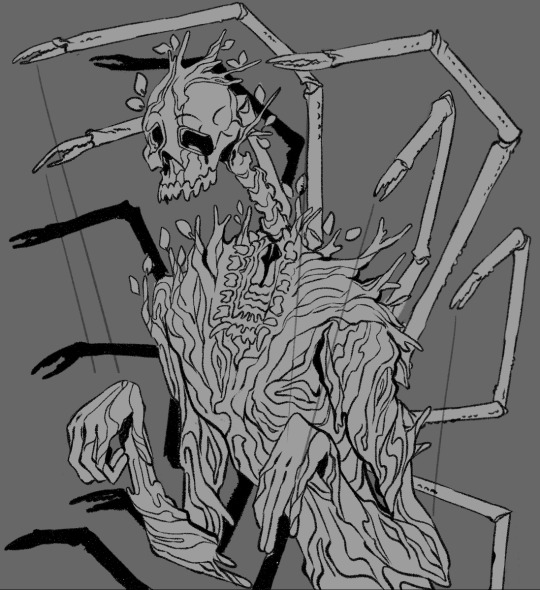#bauer zimmerman
Explore tagged Tumblr posts
Text
an analysis of the dance of death murals in act 3 of pentiment

So I finally finished the game last night and it absolutely wrecked me :') the Chapter House scene in act 3 left a huge impression on me and since I couldn't find much on the deeper meanings of the murals Andreas drew, I tried to analyze the symbolism and what they each represent :) I'm not an expert by any means so if anyone has more insight on something I haven't mentioned please feel more than free to add your own thoughts, I'd love to see them
#again guy's is a personal interpretation based on my first impressions so if you don't see my point of view that's completely fine#and im not saying that in a bad way his jewish heritage can tie into antisemitism at that time period and the accusations that came with it#and martin luther writing on jews and their lies during when the game is set……yea#i can go on forever about this game i cant wait to play through it a second time#pentiment#andreas maler#lorenz rothvogel#ottilia#sister matilda#prior ferenc#lucky steinhauer#otto zimmerman#martin bauer#hanna bergeryn#brother guy#brother guy of dijon#sister matilda of kempten#pentiment spoilers
197 notes
·
View notes
Text


107 notes
·
View notes
Text
Not necessarily who you chose, but who you think is most likely to have actually killed him
20 notes
·
View notes
Text
The Pittsburgh Penguins video staff won Emmy Awards in two categories at the 2023 Mid-Atlantic Regional Emmy Awards in Lancaster, PA on Saturday, October 14.
From the PensTV staff, Andrew McIntyre was part of two awards and Jon Otte, Leo McCafferty, Giuseppe Esposito, Sydney Bauer, Reilly Zimmerman, Ryan Mill, Jennifer Bullano Ridgley, Evan Schall and Emma Kilmer each took home one award.
Dan Potash and Fred Rihn of SportsNet Pittsburgh, formerly AT&T SportsNet, also each won an award for Talent – Sports and Writer, respectively.
Below is a full list of Penguins winners:
SPORTS PROGRAM- POST-PRODUCED OR EDITED (SINGLE PROGRAM)
“In the Room: Feeling It”- Pittsburgh Penguins
Leo McCafferty, Writer
Jon Otte, Producer
Andrew McIntyre, Producer
Giuseppe Esposito, Motion Graphics Producer
Sydney Bauer, Cinematographer
Reilly Zimmerman, Cinematographer
Ryan Mill, Narrator
Jennifer Bullano Ridgley, Coordinating Producer
Evan Schall, Coordinating Producer
Emma Kilmer, Coordinating Producer
PHOTOGRAPHER – CONTENT
Andrew McIntyre
WRITER
Fred Rihn, AT&T SportsNet
TALENT- SPORTS
Dan Potash, AT&T SportsNet
emmy award winning talent dan potash
47 notes
·
View notes
Photo










sketch dump. hi
[ID: Black and grey digital illustrations of various Blaseball players including Flattery Mckinley, Bauer Zimmerman, Mags Banananana, Adalberto Tosser, Zion Aliciakeyes, Nanci Grackle, Forrest Best, Hiroto Wilcox, Margarito Nava, and Moses Mason. The poses are simple and drawn from the chest upwards. End ID.]
#blaseball#flattery mckinley#bauer zimmerman#mags banananana#adalberto tosser#zion aliciakeyes#nanci grackle#forrest best#hiroto wilcox#margarito nava#moses mason
188 notes
·
View notes
Link
did a final blasebalnukkah wrap up/sequel to my first ever fic here’s edric tosser celebrating chanukkah through the years bc i’m a sentimental bitch like that
#Blaseball#edric tosser#morrow doyle#stu trololol#baby triumphant#bauer zimmerman#i think that's everyone#ngl this isn't my fave thing i've written but i'm posting it anyway#rather that then it just languishing in a doc i think#Hanukkah
7 notes
·
View notes
Text

this is vital information that everyone HAS to know
plus a blank version so you too, can share VITAL INFORMATION about YOUR ocs! 🎉

#oc meme#oh boy time to tag them all#adimus praviul#dominik neuhäusser#orabelle ponce#bishop marouazi#sicily anderson#saida komali#pistachio aomine#dreams#ezekiel mahanaim#luiza mendez#keon medina#clarise zimmerman#aubergine silyanova#wesley moss#porter bauer#alejandro gonzalez#vozramach#darla blanchet#merry andino#bo vulpes#tds oc vault
3 notes
·
View notes
Text
11/22 NOVEMBER NAPS
11/22 NOVEMBER NAPS
#burna boy#rosalia#sega bodega#sam gendel#balmorhea#rahill#aksak maboul#peter matthew bauer#velvet underground#kris kristofferson#daniel villareal#can#tove lo#tucker zimmerman#tears for fears#the walkmen#gary numan#basement jaxx#sea moss
0 notes
Note
Hello Josh!
In Tassing, most of its denizens' surnames seem to be more of a statement of their profession (Maler, Zimmerman, Bauer etc).
Is it a stylistic choice or was it a common thing in that period? If so, I have two additional questions:
What about Alban, Gertner or Stolz? My knowledge of German is very basic, but these seem to have not that much to do with characters' profession.
Historically, would they change when someone change their profession? It seems implied in Pentiment epilogue, in the family tree particular character does have their name changed based on their fate.
Thanks in advance for an answer and thank you for all your great work in the industry <3
It was not uncommon for surnames to reflect professions. Over time they would stick even if the family was no longer engaged in that trade. In my research, I found both surnames where the profession matched the family's (apparent) current occupations and ones where they did not. And many surnames were not profession surnames, but were tied to other things - many of which are lost to history. Not every surname can be cleanly traced to a specific origin even if there's historical evidence that it existed in a time and place.
My family name was once Sayer. It was an Austrian name that I've traced back to the late 16th century (Michael Sayer, b. 1590 in Vienna). Michael moved to what is now Baden-Württemberg in 1610. His descendants spread throughout the area. One of them, Georg Sayer, left Eningen (near Reutlingen) around 1750 and traveled down the Danube to settle in Apatin, Hungary (this was part of a larger movement promoted by Empress Maria Theresa and other Habsburgs that became known as the Danube Swabians or Donauschwaben migration).
My great-grandfather, Josef Sayer, left Apatin for America in 1909. Sayers continue to exist in Germany, specifically in Baden-Württemberg. They no longer exist in Austria. What did the name mean? Why did my great-grandfather Anglicize our name to Sawyer? It is unlikely I will ever know, and it's like that for a lot of people.
84 notes
·
View notes
Text
people keep reblogging that post about who has seen the most incinerations and being like “damn i wasn’t expecting X to be on the list” so just for funsies here is the list of everyone who they saw get incinerated
please note that these lists include both teammate incinerations and non-teammate incinerations. but for the sake of drama the teammates are italicized
beck whitney:
flowers, s1 to mid-s6: sosa elftower, famous oconnor, hurley pacheco, bryanayah chang, tyler violet, jorge ito, isaac rubberman, matheo carpenter, morrow doyle, caligula lotus
dale, mid s6-s13: dominic marijuana, murray pony, raul leal, theodore holloway, augusta chadwell
fridays, s14-s22: pudge nakamoto (the first time), alejandro leaf (the first time)
millennials, s22-s24: tot clark
dunlap figueroa:
tigers, s1 to mid-s23: juan rangel, landry violence, combs duende, emmett internet, moody cookbook, elijah bates, mclaughlin scorpler, kiki familia, antonio wallace, sebastian telephone, yazmin mason, frasier shmurmgle, hobbs cain, wichita toaster, igneus delacruz, carmelo plums, yong wright
sunbeams, s23 while super-roamin’: pudge nakamoto (the second time)
karato bean:
fridays, s1-s7: fitzgerald massey, jessi wise, hurley pacheco, sebastian townsend, sam solis, hendricks rangel, sebastian sunshine, thomas england
spies, s8-s14: case sports, raul leal, theodore holloway, norris firestar, son scotch
lovers, s15-s24: sparks beans, helga washington, jon halifax, helga moreno, peanut holloway
knight triumphant:
lovers, s1-s12: lars mendoza, zi delacruz, paul barnes, miguel javier, whit steakknife, caligula lotus, jose haley, tillman henderson
spies, s13: raul leal, theodore holloway, norris firestar
georgias, s16-s17: chorby soul (the third time), luis acevedo, hercules alighieri
steaks, mid s18-s20: chorby soul iii
lift, s21-s22: gerund pantheocide, brock forbes
steaks (again), s22-s24: helga moreno (former teammate)
spears taylor:
pies, s1 to mid-s4: alexandria dracaena, cedric gonzalez, juan rangel, kennedy alstott
tigers, mid-s4 to s8: combs duende, emmett internet, moody cookbook, elijah bates, mclaughlin scorpler, kiki familia, antonio wallace, sebastian telephone, yazmin mason, frasier shmurmgle, hobbs cain
fridays, s9-s24: hands scoresburg, pudge nakamoto (the first time), alejandro leaf (the first time)
tot fox:
jazz hands, s1 to mid-s4: alexandria dracaena, aldon anthony, cedric gonzalez, theodore passon, ogden mendoza, velasquez meadows
crabs, mid-s4 to mid-s19: combs duende, murray pony, tillman henderson, annie roland, chorby soul, luis acevedo, chorby soul iii
lovers, mid-s19 to s24: sparks beans, helga washington, jon halifax (former teammate), helga moreno, peanut holloway
wyatt pothos:
tacos, s1-s9: tyreek olive, scrap murphy, jessi wise, natha kath, blankenship fischer, hendricks rangel, sebastian sunshine, stevenson monstera, eduardo ingram, morrow doyle, richardson turquoise
pods, s10: sebastian telephone
jazz hands, s11-s24: lawrence horne, combs estes, sutton bishop, hercules alighieri, tamara crankit, bauer zimmerman
#waveridden.txt#long post //#i need a blaseball tag#some key takeaways here:#in early discipline era the tacos saw a FUCKTON of deaths. same for the fridays and flowers#the tigers also saw a lot in mid-late discipline era#the dale saw a lot in early expansion and the lovers saw a lot in late expansion#not to mention the jands expansion era curse#all this to say: you will see a Lot of repeated names on there#anyways go nuts have emotions about the people who saw people die. have fun. let me know if you have any questions#also for the record the award for 'saw most teammates die' goes to castillo turner#and the award for 'most of the deaths i saw were my teammates' goes to simon haley#it's a subtle but noteworthy distinction
36 notes
·
View notes
Note
12, 27, 40!
12. Do you have crushes on any fictional women?
Huuboy.
Lilith (CAOS), Mary Wardwell, Farah Dowling, Alcina Dimitrescu, Donna Beneviento, Rita Calhoun, Heather Dunbar, Elizabeth Keane, Sarah Winchester (played by Helen Mirren), Fiona Goode, Elsa Mars, Sister Jude, Regina Mills, Florence Zimmerman, Carol Aird, Joan Ferguson, Rita Conners, Zara Dragovich, Elizabeth Donnelly, Olivia Benson, Isobel Pickwell, Miranda Croft, Missy (Doctor Who), Queen Leonore, Talia Bauer, Ava Paige, Hela (Thor Ragnarok), Katherine Proudmoore, Moira O'hara (Frannie's version), Hannah Grose.... honestly this could take awhile, I'm just gonna leave it there 🤣🤣
27. Are there any sapphic “ships” you love?
Marith will always hold my heart, no matter what, it's my lil baby 🥺 I also like SwanQueen, Lunrah, Faralind, Madam Spellman, and FreakyTits. 🤣
40. What’s something you’re obsessed with right now?






Sapphic Ask List
17 notes
·
View notes
Text
FastNotepad
The Profession of Arms
In Care to My Good Sir, General Salazar. I have recently been briefed on your newest offensive proposal. I believe you have spent to many nights sleeping in the heat of your war tent. I think perhaps you have taken fever. A fever is the only reason I can imagine for you to have taken such leave of your senses. If I understand correctly, you are proposing a calvary charge up The Hill and even past it all the way to The Border. My god, man, I know you earned your stripes in the calvary so it surprises me that you would send so many calvary men to their deaths. I have no doubt that enemy activity on The Hill is light. General Bauer is almost certainly wants you ride up on the Hill and on towards the Border. Once over The Hill, I tell you, you’ll find yourself surrounded by Bauer’s men. If you read my book, “The Profession of Arms” you would see the trap for what it is and march your men along the River protecting my flank as I push Bauer back to the Border with my Company smashing down upon him from the Valley. Do not seek to beat the enemy in one great charge. That sort of thing might have worked in your father’s Day. But Modern warfare requires a more cautious approach. Your friend and ally, General Mendell
In Care to My Old Friend General Mendell I appreciate your concern for my health. To be sure, it is much hotter commanding an army from the field than it is from your armchair, but it allows me a clear view of the necessities of this war. I have read your book, my friend, but if you had read my book, “Waging War Professionally” you would realize that the Valley is, in fact, the death trap. I’m amazed you would ask me to wait for your company to attack General Bauer from the Valley when your “cautious” approach has kept you back at the Trenches pinned by General Zimmerman all year. I’m glad you remember my father, author of “War and the Professional” which I assume you read at your fancy school. I suggest you read it again. In it my father calls your reliance on engineers and recon deployment a surefire way to make war go on for years, killing more young men in the long run. Please stick to your arm chair. In peace time I’m sure you will be a great theoretical general. Leave war time to us professionals. I will take the Hill, and the Border and I will see you in The City. Toasting to your health, General Salazar
Dear Gentlemen Generals Salazar and Mendell This feud between the two of you is doing nobody any good. Except perhaps General Bauer and General Zimmerman. General Mendell, it is my considered opinion that your slow progress is uninspiring. What’s worse is my publicist tells me that it is thoroughly unpopular. General Salazar, in regards to your Offensive proposal, I am inclined to agree with General Mendell. Taking the Hill in brazen fury simply opens up to many chances of disaster. The only sure way to reach the Border is via the River. I’ve already drawn up a decisive strategy for pushing my fleet up the River. The enemies armies have clearly overwhelmed both of your capabilities. A naval engagement is the only viable option left to us. In my book “The Naval Profession” I outlined specifically the necessity for augmenting the army with Naval deployment. With minimal loss of life I will reclaim the Border. The two of you would be best off protecting my western flank. In sincere admiration, Admiral Dumas
To His Most Distinguished, Admiral Dumas
Dear, sir, I appreciate that your advice, however I have no need to hear from your publicist, I have my own who has served me faithfully since my first book, “A Professional’s Guide to War”. Further more, General Zimmerman’s army finally broke. I am currently moving my company towards the Valley. Forget your foolish plans for the Valley, or The River. I have pushed Zimmerman into retreat. General Bauer is next.
See you in The City, General Mendell
To The Cabal of Fools losing this war.
I can’t believe what has happened in my absence. I leave the front for three months to go on a book tour for my newest book, “Military Engagement and the Professional” and everything has gone to hell. The Esteemed Admiral wants to fight a naval battle on land, Salazar believes he can march all the way to the City in on charge, and Mendell wants credit for catching up to the rest of us. Gentleman, Salazar is right, the Hill is the key to reaching the Border, but it can’t be taken with Calvary. Artillery my boys. It worked on the other front, it can work here. To help you understand this simple concept, I have sent each of you a signed copy of my book. Happy Reading, General Samson
To My New Colleagues, I would like to take the time to introduce myself. I am General Mendell’s replacement. After the disaster in The Valley, General Mendell’s popularity hit an all time low and his removal was unavoidable. Now, you may not have heard much about my military experience but I have written five best sellers in the genre of military strategy including the “Profession of Victory” trilogy. I propose to succeed where Mendell failed by implementing the use of spy planes for intel rather than reconnaissance units.
To Our Glorious Victory, General Caldwell
To The Doomed son of the great General Salazar, General Salazar.
Please Listen to me son. I served with your father. We wrote “The Profession of Military Engagement” together. Allow me to take the Hill with my mortars. Your Calvary plan is doomed. I even the new guy Caldwell can see that, and he’s an idiot. Rather than blunder into a trap you could have the honor of protecting my flank. Don’t be a fool like Caldwell or crack pot like Admiral Dumas.
Your only chance, General Samson
To the esteemed, General Samson
General Salazar is dead. He fell prey to my ambush yesterday. I overtook his company in retreat. I am just now occupying his field tent and going through his old correspondence. I’m afraid he never received your last letter. And he never will. I had him flayed and crucified for the crime of serving your corrupt empire. The same fate awaits all of you!
Your Eternal Enemy, General Bauer. P.S. In regards to your assessment of General Caldwell and Admiral Dumas we are in complete agreement. Who attempts the exact same strategy that cost their predecessor their job? Substituting one type of recon for another. This is typical of Generals that are overly dependent on intelligence reports. In my book “The Bloodiest Profession” I make it very clear that intelligence reports are dubious at best. The best strategy is the oldest strategy. One of shock and terror. As far as Dumas is concerned, I think he feeling the effect of his usefulness disappearing. Wars are not doubt at sea anymore. I look forward to putting him out of his misery.
Dear Old Friends. I’m back! After the total failure of my predecessor in The Valley and after the tremendous success of my newest book “The Informed Professional Approach to Combat” I have been reinstated. Unfortunately under Caldwell’s leadership, we have lost track of General Zimmerman’s movement. So I am moving my company south. Since General Bauer is mobilising against General Samson I propose to attack him from his flank. You two just keep him occupied. Your retuning companion, General Mendell
To General Samson
Don’t get your hopes up on Mendell. Apparently he was ambushed by Zimmerman again. However, I had an interesting idea while having breakfast with my agent. You and I could combine strategies. You first proposed artillery. My ship’s could provide shell cover from the River as you send calvary up the Hill as the late General Salazar attempted. This would give us an opportunity to write a collaborative book. “The many Professions of War” working title. Tell me what you think. At your service, Admiral Dumas
To Admiral Dumas
I see it’s true that news travels slow at sea. My company has already taken the Hill. General Bauer has been defeated. Unfortunately we had no time to celebrate. General Zimmerman has us completely surrounded. No matter what we attempt he has a counter for. It’s as if he can read our minds. I fear this war is lost. General Zimmerman is the most brilliant opponent I have ever faced.
Final regards, General Samson the mysterious, General Zimmerman
I understand you have taken every friendly port I have left. As it is I have no choice but to sail my fleet to you under the white flag of surrender. Your leadership has been exemplary. Before I step ashore and hand you my saber, I must have you answer this question. I know very little about you, sir. Before this war I had never heard of you. Yet you seem to have the greatest military mind of this generation. What is your secret? How do you always know when to hunker down and when to charge? How do you choose calvary or artillery? Where does this clarity of battle come from? Your beaten adversary, Admiral Dumas
To the Enemy,
I read a lot.
General Zimmerman
2 notes
·
View notes
Note
Beginning/ending one syllables from last names for first names?
Hunt - Hunter, Huntson
Beck - Becker, Beckett, Beckham
Cole - Coleman
Sul - Sully, Sullivan
Coop - Cooper, Cooperman
Dune - Duncan
Griff - Griffin
Hen - Hendrix, Henson, Henderson
Len - Lennon, Lennox
Linc - Lincoln
Mill - Miller
Thom - Thompson
Zim - Zimmerman
Wall - Wallace
Bo-/Beau - Bauer
Bex - Bexley
Con - Connelly
Del - Delaney
Don - Donnelly
Hux - Huxley
Mac - Mckinley, Macintire
Mo - Morrison
Wil - Wilson
Ward - Howards
0 notes
Text
Jack Off Prelims
There will be twelve preliminary polls consisting of every valid nominated Jack that got one or two nominations. Every valid nominated Jack with 3+ nominations is already safe and secure in the Jacket which will be revealed in its completed glory once the prelims are over.
The prelims will consist of seven polls with 2-3 Jacks that received two nominations, and five polls with 7-8 Jacks that received one nomination. The winner of each poll will ascend to the Jacket!
The Jack prelims will go up after the John finals finish on April 15th, so expect the two nomination prelims on April 16th starting at 10am CST, and the one nomination prelims on April 18th starting at 11am CST. They will drop one every hour on the hour
And without further adieu, here are your Jack Off Prelim Competijacks! Below the cut!
Prelim #1: Jack Fenton (Danny Phantom) vs Jack Crichton (Farscape)
Prelim #2: Jack Torrance (The Shining) vs Jack Dawson (Titanic)
Prelim #3: Jack Shephard (Lost) vs Jack Crawford (Hannibal)
Prelim #4: Jack-Jack Parr (The Incredibles) vs Jack Kennedy (Dayshift at Freddy’s)
Prelim #5: Big Jack Horner (Puss in Boots: The Last Wish) vs Jack Merridew (The Lord of the Flies)
Prelim #6: Jack Aubrey (Master and Commander) vs Jack Wolcott (Wayward Children)
Prelim #7: Jack the Re-Animator (Jessica Law) vs Jack Barnabas (The Magnus Archives) vs Jack (Mass Effect)
Prelim #8: Jack Starbright (Alex Rider) vs Jack Zimmerman (Check, Please!) vs Jack Jackson (Kingsbridge) vs Jack Wright (Namesake) vs Lavender Jack (Lavender Jack) vs Jack Hart/Jack of Hearts (Marvel) vs Jack Drake (DC)
Prelim #9: Jack Baker (Resident Evil: Biohazard) vs Jack (Boomer) (Fallout: New Vegas) vs Raiden “Jack the Ripper” (Metal Gear) vs Jack Howl (Twisted Wonderland) vs Jack-of-Smiles (Fallen London) vs One-Eyed Jack (The Mechanisms) vs Spring-Heeled Jack (Folklore)
Prelim #10: Jack/J.T Fields (Old Gods of Appalachia) vs Jack Larson (Malevolent) vs Jack Danger (Brooklyn Nine-Nine) vs Jack Bauer (It’s Always Sunny in Philadelphia) vs Jack Secord (Warehouse 13) vs Jack the Front Loader (Thomas the Tank Engine) vs Jack I. Box (Mascot)
Prelim #11: Jack Napier (DC) vs Jack Chambers (Don’t Worry Darling) vs Jack Frost (Jack Frost) vs Jack the Monkey (Pirates of the Caribbean) vs Jack o’ the Green (Legend) vs Jack/Narrator (Fight Club) vs Jack Sadelstein (Jack and Jill)
Prelim #12: Jack Donaghy (30 Rock) vs Jack Carter (Eureka) vs Calico Jack (Our Flag Means Death) vs Jack Porter (Revenge) vs Jack Deveraux (Days of Our Lives) vs Jack Bristow (Alias) vs Jack Hodgins (Bones) vs Jack Gibson (Station 19)
#jacks will be tagged on their polls#but not here#because god there’s 51 of them#feel free to send any questions to my ask box
6 notes
·
View notes
Text
Baseball’s Top Staffs Have Come Around On The High-Spin Fastball
When baseball welcomed the new Statcast technology to every major league stadium in 2015, the system’s Doppler radar began tracking an underlying pitching skill: spin rate. Teams and players were suddenly armed with new data to study and optimize. They were able to quantify long-held beliefs about pitch characteristics, like “late life” and “rise,” and challenge established practices, like always keeping the ball down as a pitcher.
As batters have adjusted their swings lower to crush the sinking fastball, more and more pitchers have sought to go up in the zone, above uppercut swing planes, with elevated fastballs. In every year of Statcast pitch tracking, the average height of four-seam fastballs upon reaching the plate has increased. And adding spin to the four-seam fastball is what makes it a bat-missing weapon. The teams that harness those high-spin pitches seem to have an advantage in getting to October: The Houston Astros, New York Yankees, Los Angeles Dodgers and Cleveland Indians are the top four teams in spin rate on four-seam fastballs, and the Boston Red Sox are ninth.
Leaguewide batting averages offer a snapshot into the importance of spin. When pitchers threw fastballs between 93 and 94 mph with an average spin range of 2,240 to 2,300 revolutions per minute, hitters posted a .279 average this season. But against the same velocity range with an increased spin of 2,540 to 2,600 rpms, batting average declines to .255. The more spin a fastball has, the more it appears to rise and resist gravity, and that creates more swings and misses, as demonstrated by Jeff Zimmerman of FanGraphs.
But how can a player — or a whole team — develop high spin rates? Some players have high fastball spin rates innately, and others don’t — changing grip on a breaking ball can change spin rate, but it’s difficult to throw a fastball differently. Unlike velocity, which can be trained, a pitcher’s fastball spin ratio is thought to be extremely difficult to alter naturally.
The unnatural solution is for a pitcher to apply a foreign substance. In May, Cleveland Indians pitcher Trevor Bauer drew the ire of the Houston Astros when he addressed the subject of sticky substances and their effect on performance.
“There is a problem in baseball right now that has to do with sticky substances and spin rates,” Bauer said. “We know how it affects spin rate and we know how spin rate affects outcomes and pitches and movements that have a big difference in a game, a season and each individual player’s career.”
“The people who choose not to do it are at a competitive disadvantage.”
When a thrown ball departs from a straight path, it’s because the speed of its spin creates a pressure differential. The ball moves toward the direction of lower pressure. In baseball, this phenomenon — known as the Magnus Effect — combines with the orientation of the ball’s spin axis to force a curveball to break downward and a slider to move more laterally. More spin equals more movement. The Magnus Effect forces a four-seam fastball in another direction: up.
Just about every four-seam fastball is thrown in a similar manner, with the index and middle fingers of the throwing hand last making contact with the ball. Bauer, who’s known for taking a scientific approach to pitching, explained that to increase spin on four-seam fastballs, the pitcher’s fingers must maintain contact longer to form a more acute tangential angle with the ball. Bauer believes this is largely an innate trait — unless a sticky substance helps the fingers adhere to the ball for a fraction of second longer.
University of Illinois physics professor Alan Nathan, an MLB consultant, agreed with Bauer’s theory.
“It’s probably pretty hard to change that [fastball spin] ratio for an individual,” Nathan said of naturally changing spin rate. “I can see that you could do it for a curveball because a curveball involves some technique whereas a fastball is pure power. There is no finesse.”
It seems like Bauer tried to prove his point with an on-field experiment. During the season, Bauer ranked 164th out of 495 pitches in average spin rate at 2,322 rpms. But in one inning of an April 30 start in Texas, Bauer’s average spin rate surged while his velocity remained steady. He came close to hitting 2,700 rpm with a fastball — more than 300 rpms above his average.
Bauer was asked after the game if he had used a foreign substance in that inning, and he said simply, “No comment.” He did acknowledge testing different substances in the lab at Driveline Baseball in Washington state, where he trains and researches in the offseason.
“I’ve melted down Firm Grip and Coca-Cola and pine tar together,” Bauer told reporters in May. “I’ve tested a lot of stuff. At 70 mph, when we were doing the tests, spin rates jumped between 300-400 rpm while using various different sticky substances. The effect is slightly less pronounced at higher velocities … but still between 200–300 rpm increase.”
Driveline Baseball has tried to make it easier to measure spin rate. It released a metric in November 2016 called “Bauer Units,” a measure for spin divided by velocity. That allows us to look across teams and isolate which players might be generating spin more than others. And some of the most analytically driven teams seemed to valued spin more as soon as Statcast began measuring.
Raw spin rate generally increases with velocity, but it’s the spin-to-velocity (rpm-to-mph) ratio that is so crucial to determining pitch movement. For instance, a high-velocity fastball with just average spin will not have as great of a rise effect as a lower-velocity, higher-spin fastball will. The ideal fastball is high-spin, high-velocity, like that of Justin Verlander. The Astros ace ranks second in baseball in vertical movement of his fastball, at 11.2 inches, with an average velocity of 95 mph. His fastball generates 29.4 percent whiffs per swing, seventh in baseball. It’s that rpm-to-mph ratio that is considered difficult to improve in fastballs by those who, like Bauer, have experimented in lab settings.
In recent seasons, the Astros added spin outliers in Verlander and Ryan Pressley, who rank fifth and 10th in raw fastball spin rate and fifth and 16th in Bauer Units. (Bauer ranks 162nd out of 348 pitchers in Bauer Units.) The Yankees acquired Aroldis Chapman and Sonny Gray. The Dodgers made a significant investment, three years and $48 million, in elite spin-rate artist Rich Hill after the 2016 season despite his lengthy history of injury and inconsistency.
The Dodgers, Astros and Yankees rank first, third and fourth in Bauer Units this season. And since 2015, those same three team lead in Bauer Units added, suggesting that they better prize and/or teach the skill. All three teams declined interview requests on how they evaluate and develop spin.
Which MLB teams are prizing spin?
MLB teams by change in average rate of four-seam fastball revolutions per minute/miles per hour between 2015 and 2018*
TEAM Change in average Fastball RPM/MPH, 2015-18 New York Yankees +1.47
–
Los Angeles Dodgers +1.12
–
Houston Astros +0.90
–
Texas Rangers +0.88
–
Milwaukee Brewers +0.84
–
New York Mets +0.78
–
Boston Red Sox +0.63
–
Arizona Diamondbacks +0.55
–
Pittsburgh Pirates +0.54
–
Colorado Rockies +0.53
–
St. Louis Cardinals +0.52
–
Seattle Mariners +0.46
–
Los Angeles Angels +0.37
–
Cleveland Indians +0.34
–
San Diego Padres +0.33
–
Chicago Cubs +0.32
–
Minnesota Twins +0.28
–
Detroit Tigers +0.22
–
Atlanta Braves +0.22
–
Toronto Blue Jays +0.07
–
Washington Nationals -0.06
–
San Francisco Giants -0.08
–
Baltimore Orioles -0.14
–
Miami Marlins -0.16
–
Tampa Bay Rays -0.17
–
Philadelphia Phillies -0.17
–
Kansas City Royals -0.40
–
Oakland Athletics -0.62
–
Chicago White Sox -0.80
–
Cincinnati Reds -0.99
–
* 2018 data through Sept. 20
Source: Baseball savant
Teams can acquire known high-spin pitchers, but whether individual teams and players can improve their spin ratios is another question. If a team or individual can learn how to alter fastball spin naturally, they would have a major competitive advantage. (Driveline Baseball’s Kyle Boddy wrote on Twitter earlier this year that one way to increase fastball spin without substance would be to throw a hybrid four-seam/cut fastball.)
Eno Sarris found for The Athletic that pitchers joining the Astros have enjoyed small spin gains on average, but not every pitcher has made gains. FanGraphs found that the Blue Jays, Yankees, Rockies, Tigers and Astros added the most spin to new arrivals, often modest gains.
Gerrit Cole of the Astros and Clayton Kershaw of the Dodgers are elite pitchers who have made significant gains in spin. Only Jorge De La Rosa had a greater year-to-year Bauer Unit improvement on his fastball (+2.31 rpm/mph) than Cole (+2.01 rpm/mph), according to a FiveThirtyEight analysis of Statcast data through Sept. 20. Since 2015, Kershaw has added the most spin relative to velocity. His spin rate has increased from 2,217 rpms on average in 2015 to 2,388 this season despite his average fastball velocity falling from 94.2 mph in 2015 to 90.7 this season. That helped Kershaw rank fourth in vertical fastball movement among starters, or average rise, with 10.9 inches this season.
Cole has always had one of the top fastball velocities in the game. The pitch averaged 96.6 mph for him this season1 after he posted a 95.9 mph mark last season. But his average spin increased from 2,164 rpms last season to 2,374 this season. Cole ranks 34th in rise (9.7 inches vertical inches) among 176 starting pitchers to have thrown 200 fastballs this season and ninth in whiffs per swing (29.3 percent). Cole ranked 127th in vertical rise on his fastball last season (8.8 inches) and 37th in whiffs per swing (21.6 percent), among 189 qualified pitchers.
In May, Cole told me that he learned to release the ball differently after working with Verlander, changing the pitch’s spin axis by looking for “true rotation and hop” and “staying behind the ball better.” Cole said the Astros also worked with him on pitch usage and location.
Astros manager A.J.Hinch said in a radio interview that Cole is throwing fewer two-seamers, a lower-spin pitch that is sometimes mislabeled by Statcast, and that Cole has made “subtle tweaks.” Cole did record several high-spin fastballs in Pittsburgh that seemed to be outliers, so baseball blogger Saul Forman suggested that the Astros might have simply identified an untapped skill. Cole finished this season fifth in baseball in pitching wins above replacement.
Statcast technology is imperfect. Hinch is right in saying that Statcast doesn’t label every pitch correctly. And its Doppler radar doesn’t read spin axis,2 which means that Statcast does not differentiate between transverse spin — which is sensitive to Magnus Effect — and gyrospin, which is not. Transverse spin is front spin (for a curveball or slider) or backspin (for a fastball) that rotates around an axis that is perpendicular to direction of motion. Gyrospin is like that of a bullet or football thrown in a spiral. A gyrospin axis is in line with the direction of motion. Most pitches have an element of each type of spin. Still, of all pitches, the four-seam fastball has the most consistent spin axis, Nathan said, so it should be most accurate to evaluate via Statcast.
Major league rules state that no pitcher may apply “a foreign substance of any kind to the ball,” but the rule is rarely invoked — you’ll often see MLB pitchers tugging at their caps or touching their nonthrowing arms on the mound. When the rule is enforced, the offense is usually egregious — like in 2014 when Yankee Michael Pineda was ejected and ultimately suspended for putting pine tar on his neck and then on the baseball.
We reached out to the MLB Commissioner’s Office last week, but it declined to comment on whether the league is investigating high spin rates.
Opposing teams can ask umpires to check for substances, but that’s a rare occurrence. Indians manager Terry Francona actually apologized to Hinch in May for the spin-talk controversy on social media.
“You’ve never seen me go out and challenge anybody because, if I feel like somebody is trying to grip the ball, I’m glad,” Francona said. A firmer grip might increase spin, but it also might prevent a pitcher from beaning a batter. “Yeah, they might make a better pitch, but there would not be a worse feeling than, as a hitter, knowing that this guy might let this one fly … What happens sometimes is when guys do stuff blatantly, it puts everybody in a tough spot, because it’s a rule, but he’s just trying to hold the ball.”
Baseball has a long history of living with some common forms of rule-bending, such as sign stealing, scuffing baseballs and neighborhood plays. Even Bauer agrees that enforcing the rule isn’t the answer.
“Allow it. I don’t see the there’s a way to enforce it,” he said in May. “So pick a substance that’s sticky … and just put it on the back of the mound.”
MLB might have its own solution down the road: a tackier ball that is in development. The Indians were among the teams that tested the new ball this spring.
“ I just hope that at some point, maybe we can morph into that,” Francona said, “because I think maybe it could be really helpful.”
Of course even a tackier ball could always be tackier. Players and teams will probably always be looking an edge, particularly now that they can quantify the power of spin.
Check out our latest MLB predictions.
from News About Sports https://fivethirtyeight.com/features/baseballs-top-staffs-have-come-around-on-the-high-spin-fastball/
0 notes
Text
MADISON, Wis | $30 million poured into effort to energize young voters
New Post has been published on https://is.gd/nwMkzp
MADISON, Wis | $30 million poured into effort to energize young voters
MADISON, Wis — Democrats know who their voters are. They just have to figure out how to get them to the polls in November — and that’s where the puppies come in.
Students returning to the University of Wisconsin-Madison campus this summer were greeted by therapy dogs for petting. Those lured by the chance to ruffle a dog’s ears were then asked to register to vote — a “Pups to the Polls” gimmick that was just one of several similar events being staged in 11 battleground states by the liberal group NextGen America.
Young people tend to vote for Democrats, but they also tend stay away during midterm elections. It’s a perennial frustration for the party — one they are trying to overcome as they seek to take control of Congress.
NextGen America, formed by billionaire activist Tom Steyer, hopes to be a game changer. Steyer is investing more than $30 million in what’s believed to be the largest voter engagement effort of its kind in U.S. history.
The push to register and get pledges from college students to vote is focusing on states such as Wisconsin, Virginia, California and North Carolina with competitive races for Congress, U.S. Senate and other offices.
NextGen sees young voters such as Kellen Sharp as key to flipping targeted seats from red to blue.
“The outcome of this election definitely affects us,” said Sharp, an 18-year-old freshman from Milwaukee who stopped to register during the dog event the week before classes started. “I’m just excited to have a voice and say something.”
A poll this summer by the Associated Press-NORC Center for Public Affairs Research and MTV found that most Americans ages 15 to 34 think voting in the midterm elections gives their generation some say about how the government is run. The poll found young people eager to vote for someone who shared their political views on issues such as health care and immigration policy. They expressed far less excitement about voting for a candidate described as a lifelong politician.
“If we all vote, we can make a change,” said 20-year-old Grace Austin, who stopped to pet the dogs at the Wisconsin event and wound up registering to vote.
Austin and other college students who registered said they feel like their friends are more interested in politics than ever before — boosting hopes of Democrats trying to reverse the trend of declining youth participation in midterm elections.
“We want them to know they need to show up and when they do, we will win,” said NextGen’s Wisconsin director George Olufosoye. “We want them to know they have power.”
They certainly have the numbers.
Since the last midterm election in 2014, 15 million post-millennials — those between the ages of 18 and 21 — have become eligible to vote. But while Generation X, millennials and post-millennials make up the majority of voting-eligible adults nationwide, they are not expected to cast the most votes in November.
In the 2014 midterm, they cast 21 million fewer votes than voters over age 54, according to an analysis by the Pew Research Center.
Turnout among 18- to 24-year-olds hit a 40-year low in 2014, bottoming out at 17.1 percent, according to an analysis by the Center for Information and Research on Civic Learning and Engagement, or CIRCLE, at Tufts University.
NextGen points to higher voter turnout on the University of Wisconsin campus for a spring state Supreme Court election won by a liberal, and spikes in turnout in other targeted races, to argue that their push to register 122,000 young people to vote is bearing fruit.
“We’re trying really hard to have this be much more of an infrastructure, organizational thing than a two-month campaign,” NextGen founder Tom Steyer said in an interview. “We’re trying to get the broadest possible democracy, the biggest representation.”
More media coverage of competitive races, combined with energy from the March for Our Lives movement that seeks stricter gun laws, has empowered young voters and made them “feel like it’s time to have their voice heard about what happens to their generation,” said Kei Kawashima-Ginsberg, director of CIRCLE.
That’s what NextGen hopes. It has nearly 800 organizers on 421 college campuses in Wisconsin, Arizona, California, Florida, Iowa, Michigan, Nevada, New Hampshire, North Carolina, Pennsylvania and Virginia. In Wisconsin alone, NextGen has 27 full-time workers and 40 student fellows registering voters on 26 campuses.
Republicans recognize the power that motivating young voters could have for Democrats, but they’re skeptical that participation will increase much. In Wisconsin, Republicans have been targeting college voters for years.
“Wisconsin Republicans win by connecting with voters directly where they are — and young voters are no different when it comes to that strategy,” said Wisconsin Republican Party spokesman Alec Zimmerman.
Wisconsin has two of the nation’s competitive and closely watched races. Democratic Sen. Tammy Baldwin is being challenged by GOP state Sen. Leah Vukmir, while Republican Gov. Scott Walker faces a challenge from Democratic state schools chief Tony Evers. Polls show the races to be a dead heat — just the kind of competitive elections research shows excite younger voters.
“I’ve never seen anything like this,” said NextGen worker and 2016 University of Wisconsin graduate Joe Waldman. “I’ve never seen the energy, passion and activism there is now.”
By SCOTT BAUER, Associated Press
0 notes